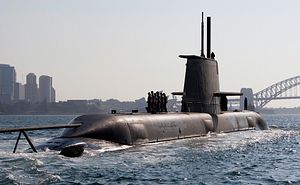Australia’s “competitive evaluation process” is pitting Japanese, German, and French submarine builders against each other in a bid to secure a A$50 billion ($38.84 billion) contract to build six to 12 submarines for the Royal Australian Navy (RAN). But the competitors – Japan’s Kawasaki Heavy Industries and Mitsubishi Heavy Industries, Germany’s ThyssenKrupp Marine Systems (TKMS), and France’s state-controlled DCNS – are not competing solely on the basis of their design’s superiority, but also on the basis of how far they are willing to go to accommodate South Australian voters’ demands for jobs, and assuage the Liberal party’s concerns about their electoral viability.
Australia is looking for a long-range submarine, about 4,000-tonnes, bigger than the 3,300-tonne Collins that it currently fields. To compete against Japan’s 4,200-tonne Soryu class, TKMS is submitting a 4,000-tonne Type 216, and DCNS is offering a smaller, non-nuclear variant of its 5,300 tonne Barracuda-class submarines.
As part of the ten-month process, Australia is asking each of the competitors to submit three different plans – a plan for building all the submarines in Australia, a plan for building all the submarines abroad, and a hybrid plan that will allow for a mix of production sites.
Due to the secrecy surrounding Japanese interactions with the prime minister’s office, Tony Abbott has been accused of concluding a “secret deal” with Japan. Such charges are overblown, but Abbott’s preference for working with Japan – in part because of U.S. enthusiasm for a Australia-Japan venture – is well documented.
In contrast to TKMS and DCNS’s frank willingness to build in Australia – if that will win them the contract – Japan has been extremely reluctant to consider building in Australia. As recently as early June, Japanese defense officials questioned Australia’s ability to build a high-tech submarine, inviting backlash from Independent South Australian Senator Nick Xenophon. Masao Kobayashi, former commander of the Japanese submarine fleet, told the Australian Broadcasting Corporation: “They don’t have enough skilled workers to fashion the high-tension steel [in Australia]; it’s even hard to do in Japan.” Toshihide Yamauchi, also a former Japanese submarine captain, raised a separate set of concerns about “leaks to China once our technology is in Australia.”
However, more recent signs indicate that Japan is willing to do what it takes to accommodate Abbott’s balancing act. Japan is now considering working with Saab, a Swedish shipbuilding company, to build some of the submarines in Australia. Saab already does submarine work with Japan and in Australia, and could help ease Japan’s transition into becoming a major weapons exporter. For example, Saab already has 350 specialist staff in Australia.
Another option for Japan is to work with British companies, as sources in Tokyo have told Reuters. Babcock International Group and BAE Systems have reportedly approached Mitsubishi and Kawasaki offering help, and other British defense contractors may be involved as well. Again, the main advantage to Japan of working with British contractors would be to smooth its entry into the global weapons market writ large, as well as Australian shipyards on the ground. Specifically, Babcock does maintenance work on Australia’s Collins class, and BAE Systems employs 4,500 people in Australia.
After dragging their feet for so long, what could have forced Japanese bureaucrats to come around to the inevitability of building at least some (or parts) of the submarines in Australia? Xenophon’s visit to Japan may have been a major factor. During the trip, he spoke bluntly of the political catastrophe that could befall the Liberal party if a purely foreign build is selected. Xenophon has declared to Japan that “if the Australian government makes a decision to build the submarines overseas[,] the winning country will find itself in the middle of a huge political backlash.”
Xenophon is the darling of those opposed to a foreign build. He has already threatened to run candidates against Abbott’s Liberal party in South Australia. Liberals know that the decision of where to build these submarines – a decision about Australian jobs and tax dollars – will play a large role in the next federal election, which is not too far in the future, as Australia must hold its next lower house election by January 2017. Faced by the stark realities of Australia’s politics, Japan is tentatively beginning to explore ways to compensate for its lack of experience.
Meanwhile, DCNS is bending over backwards to get Australian politicians to accept their bid. France has promised to share stealth technology, which it has never before shared with a foreign country. DCNS spokeswoman Jessica Thomas explained:
“These technologies are the ‘crown jewels’ of French submarine design knowhow and have never been offered to any other country. … By the very nature of these stealth technologies and the decision to release them to the Australian government, this is a significant demonstration of the strategic nature of this program for the French authorities.”
TKMS is also upping the ante by promising to transfer manufacturing know-how to local companies and take a stake in the Australian Shipbuilding Corporation if awarded the contract. TKMS has ambitions to transform Australia into a shipbuilding and maintenance hub of the Asia-Pacific.
While European partners are demonstrably more eager to build in Australia – and hence, better for Abbott’s political fortunes – as extra-regional actors, a submarine deal with either France or Germany will not create the same sort of regional grouping that a Japan-Australia deal could.
Ultimately, Abbott is seeking a deal with Japan, despite the high political risks, because he sees the deal with Japan as a way to put a down payment on supporting the U.S.’s “rebalance” to the Asia-Pacific through burden-sharing. A successful Japanese bid not only increases Australia’s own defense capabilities through a submarine upgrade, but also helps boost Japan’s defense industry by allowing Japan to export a major weapons platform for the first time since the end of WWII.

































